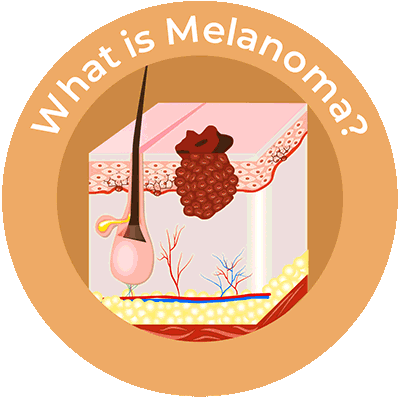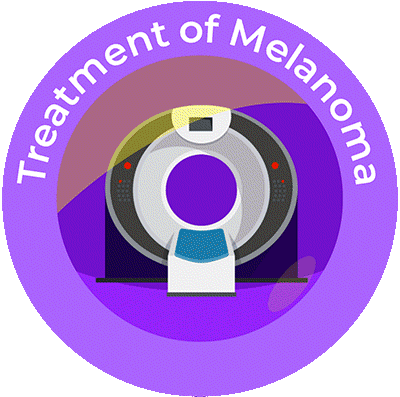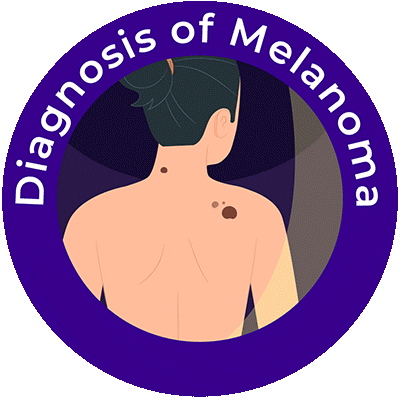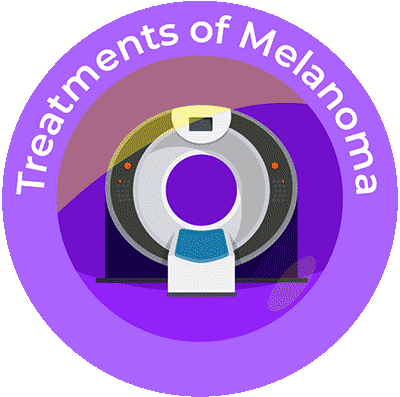This activity is provided by Med Learning Group.
This activity is supported by an independent medical education grant from Regeneron Pharmaceuticals, Inc.
Copyright © 2024 Med Learning Group. Built by Divigner. All Rights Reserved.
What is Melanoma?
The skin is made up of three layers, the outermost, called the epidermis, the middle layer called the dermis, and the innermost layer, called the hypodermis, which is composed of fat. The innermost layer of the epidermis, located right above the dermis consists of cells called melanocytes. These produce melanin, responsible for the skin’s color.

Melanoma is cancer of the melanocytes when these cells begin to grow uncontrollably leading to a tumor.2 . When melanocytes start to spread to nearby lymph nodes and/or other sites of the body, the cancer is termed as advanced or metastatic melanoma.3
Broadly, the four main types of melanomas are: superficial spreading melanoma, lentigo maligna melanoma, nodular melanoma, and acral lentiginous melanoma. Superficial spreading melanoma accounts for about 70% of melanomas, followed by nodular melanoma that accounts for 15% of melanomas. Lentigo maligna is seen in older patients and is commonly seen in areas exposed often to sunlight. Acral lentiginous melanomas typically develop in darker skinned people, appear on the palms, soles, and under the nail bed, and are not related to sun exposure.4
Melanomas can also be classified based on the mutations in certain genes seen in the melanoma cells. These include:
- BRAF mutations seen in 50% of melanomas
- NRAS mutations seen in 20% of melanomas
- NF-1 mutations seen in 10%-15% of melanomas
- KIT mutations seen in melanomas arising from sun damaged skin.4
Stages of Melanoma
Melanoma staging is determined by the TNM system. T stands for tumor and is used to indicate the thickness of the melanoma (Breslow measurement) and the ulceration or breakdown of the skin over the melanoma. Melanomas that are less than 1 mm thick and those that are not ulcerated have a very small chance of spreading. N stands for lymph nodes and is used to indicate spread of the disease to nearby lymph nodes. M stands for metastasis and is indicative of whether the cancer has spread to distant lymph nodes and/or distant organs.3 Stage IV melanoma is defined as advanced or metastatic melanoma. A sentinel lymph node biopsy can also be used for staging of melanomas and further information can be found in the Symptoms and Diagnosis section.5

Statistics
Melanoma is the fifth most common cancer among men and women in the United States. In 2022, the United States is expected to have about 57,180 men and 42,600 women diagnosed with melanoma. The average age of diagnosis is 65 years, and melanoma is about 20 times more common in White people than Black people. While the incidence of melanoma was on a sharp rise for decades, the incidence rates have decreased in people aged under 50 years by about 1% annually from 2005 to 2018. Accounting for only 1% of all skin cancers diagnosed, melanoma is responsible for most of the deaths due to skin cancer.6

Risk Factors
Melanoma, when detected early, can often be cured with surgery. Metastatic or advanced melanoma is one of the most serious forms of skin cancer, and early detection is key to a good prognosis.

References
- National Cancer Institute. Melanoma Treatment (PDQ®) – Health Professional Version. https://www.cancer.gov/types/skin/hp/melanoma-treatment-pdq
- Net. Melanoma: Introduction. Approved December 2021. https://www.cancer.net/cancer-types/melanoma/introduction
- American Cancer Society. Melanoma Skin Cancer Stages. https://www.cancer.org/cancer/melanoma-skin-cancer/detection-diagnosis-staging/melanoma-skin-cancer-stages.html
- Net. Melanoma: Diagnosis. https://www.cancer.net/cancer-types/melanoma/diagnosis
- National Cancer Institute. Sentinel Lymph Node Biopsy. https://www.cancer.gov/about-cancer/diagnosis-staging/staging/sentinel-node-biopsy-fact-sheet
- Net. Melanoma: Statistics. https://www.cancer.net/cancer-types/melanoma/statistics
- American Cancer Society. Cancer Facts and Figures 2022. https://www.cancer.org/content/dam/cancer-org/research/cancer-facts-and-statistics/annual-cancer-facts-and-figures/2022/2022-cancer-facts-and-figures.pdf
- National Comprehensive Cancer Network. NCCN Guidelines for Patients. Last Revised 2021. https://www.nccn.org/patients/guidelines/content/PDF/melanoma-patient.pdf
All URLs accessed on January 9, 2023.












